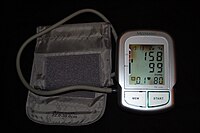
Photo from wikipedia
OBJECTIVE Office blood pressure measurement is a recommended procedure by clinical guidelines. We designed the study to know the degree of blood pressure control by clinical measurement using an automatic… Click to show full abstract
OBJECTIVE Office blood pressure measurement is a recommended procedure by clinical guidelines. We designed the study to know the degree of blood pressure control by clinical measurement using an automatic delayed-reading oscillometric device. DESIGN AND METHOD During one month we collect demographic and clinical data, office attended systolic blood pressure and diastolic blood pressure measured with an automatic device with a delayed start of the measurement and, if performed, data from ambulatory blood pressure monitoring. RESULTS We included 102 patients (67 men), with a mean age of 64.9 years, 30% diabetic and 34% with cardiovascular complications. 70% had a controlled hypertesion (<140/90 mmHg) by office blood pressure, the mean systolic blood pressure was 131 ± 16.5 mmHg and the diastolic blood pressure was 73 ± 9.5 mmHg which is a high percentage compared with other studies. Old age and diabetes were associated with uncontrolled hypertension. Thirty three patients had ambulatory blood pressure monitoring data, which allowed them to be classified according to the 24-hour blood pressure into: 30% true normotension, 9% white-coat hypertension, 15% sustained hypertension, and 45% masked hypertension. Therefore, ambulatory measurements did not confirm the good blood pressure control. CONCLUSIONS The use of automatic delayed-reading device reduces the white-coat phenomenon, improving the percentage of patients with office blood pressure controlled. However, this control is not confirmed outside the clinic, showing the importance of ambulatory blood pressure monitoring in the global evaluation of hypertension control. Aspects such as the presence or not of an observer, the number of blood pressure readings and the use of validated automatic devices with or without delayed start of the measurement should be the subject of clinical studies to determine the optimal technique for measuring office blood pressure.
Journal Title: Journal of hypertension
Year Published: 2022
Link to full text (if available)
Share on Social Media: Sign Up to like & get
recommendations!